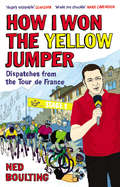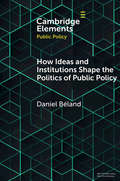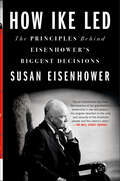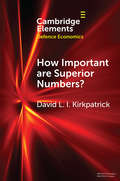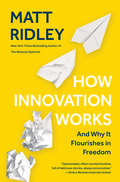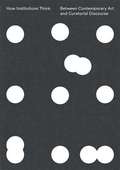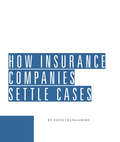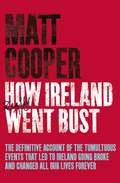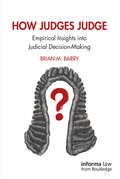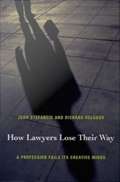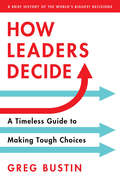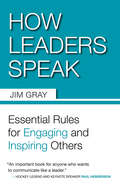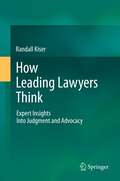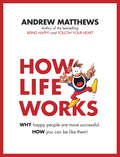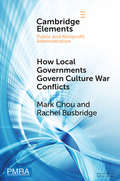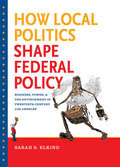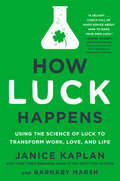- Table View
- List View
How I Won the Yellow Jumper: Dispatches from the Tour de France
by Ned Boulting'Paris, 4 July 2003: My first Tour de France. I had never seen a bike race. I had only vaguely heard of Lance Armstrong. I had no idea what I was doing there. Yet, that day I was broadcasting live on television. I fumbled my way through a few platitudes, before summing up with the words, "...Dave Millar just missing out on the Yellow Jumper." Yes, the Yellow Jumper.'Follow Ned Boulting's (occasionally excruciating) experiences covering the world's most famous cycling race. His story offers an insider's view of what really goes on behind the scenes of the Tour. From up-close-and-personal encounters with Lance Armstrong to bewildered mishaps with the local cuisine, Ned's been there, done that and got the crumpled-looking t-shirt. Eight Tours on from Ned's humbling debut, he has grown to respect, mock, adore and crave the race in equal measure. What's more, he has even started to understand it. Includes How Cav Won the Green Jersey: Short Dispatches from the 2011 Tour de France
How IT Savvy Are You and Your Colleagues?--An Assessment Tool
by Jeanne W. Ross Peter WeillThis chapter provides a questionnaire that will help you assess the level of IT savvy in your organization. Consider your firm's practices in each of five areas and determine how to move forward and make improvements to your digitized platform. This chapter was originally published as the appendix to "IT Savvy: What Top Executives Must Know to Go from Pain to Gain."
How Ideas Move: Theories and Models of Translation in Organizations (Routledge Studies in Innovation, Organizations and Technology)
by John Damm ScheuerThis book builds on research in translation studies of change in organizations and demonstrates the implications and application of these findings for managing innovation and change. When implementing ideas into practice in order to carry out innovative change, translation is key. From strategic and leadership changes to policy and health management decisions, abstract ideas such as ‘LEAN’, ‘CSR’, ‘Sustainability’, ‘Public-Private Partnerships’, ‘Clinical Pathways’ and ‘AI’ are introduced to improve organizational processes. However, in any company and organization, miscommunication and misinterpretation can lead to these ideas being modified, added to and appropriated in ways that make them unsuccessful. This book presents a case for change ideas in organizations being translated rather than “implemented” and offers a profound understanding of the translation processes needed in order for this to succeed. This vital study is a must-read for researchers, students and practitioners including change agents, general and health care managers, public servants as well as strategic managers and policy decision-makers.
How Ideas and Institutions Shape the Politics of Public Policy (Elements in Public Policy)
by Daniel BélandThis Element provides a critical review of existing literature on the role of ideas and institutions in the politics of public policy with the aim of contributing to the study of the politics of public policy. Because most policy scholars deal with the role of ideas or institutions in their research, such a critical review should help them improve their knowledge of crucial analytical issues in policy and political analysis. The following discussion brings together insights from both the policy studies literature and new institutionalism in sociology and political science, and stresses the explanatory role of ideas and institutions.
How Ike Led: The Principles Behind Eisenhower's Biggest Decisions
by Susan Eisenhower“Lays bare the essence of [President Eisenhower’s] leadership in war and peace—his singular devotion to the unity and security of the American people.” —The Wall Street JournalFew leaders have made decisions as momentous—and varied—as Dwight D. Eisenhower. From D-Day to Little Rock, from the Korean War to Cold War crises, from the Red Scare to the Missile Gap controversies, Ike was able to give our country eight years of peace and prosperity by relying on a core set of principles. These were informed by his heritage and upbringing, as well as his strong character and personal discipline—but he also avoided making himself the center of things. He was a man of judgment, and a steadying force. He sought national unity by pursuing a course he called the “Middle Way” that tried to make winners on both sides of any issue.Ike was a strategic, not an operational leader, who relied on a rigorous pursuit of the facts for decision-making. His talent for envisioning a whole, especially in the context of the long game, and his ability to see causes and various consequences, explains his success as Allied Commander and as President. After making a decision, he made himself accountable for it, recognizing that personal responsibility is the bedrock of sound principles.Written by his granddaughter, a policy analyst and national security expert, How Ike Led reveals the personality, beliefs, and habits that allowed Eisenhower to lead America through a transformational time.“As good a picture of Ike as we have ever had.” —David Nichols, author of Eisenhower 1956“Highly personal anecdotes supplement [the author’s] research. Armchair historians will treasure this book.” —BooklistIncludes photographs
How Important are Superior Numbers?: A Reappraisal of Lanchester's Square Law (Elements in Defence Economics)
by David L. KirkpatrickA century ago Frederick Lanchester formulated a mathematical model of combat which suggested that the combat power of a military force was proportional to the product of the individual effectiveness of the units in the force and the square of the number of units deployed. This model reinforced a long-established faith in the importance of superior numbers. However, successive historical studies failed to identify any clear relationship between the numbers and losses in opposing forces. This Element analyses American Civil War battles, and shows that the ratio of losses incurred was inversely proportional to the ratio of numbers effectively engaged. This result demonstrates that the numbers of fighting units in a military force are less important than the ability of those units to get into action and inflict losses on the enemy. This result demonstrates the limitations of the Square Law, and should prevent it from being applied indiscriminately.
How Information Gives You Competitive Advantage
by Michael E. Porter Victor E. MillarInformation technology is more than just computers. It must be conceived of broadly to encompass information as well as a spectrum of technologies that process the information. An important concept that highlights the role of information technology is the "value chain." This concept divides a company's activities into the technologically and economically distinct activities it performs to do business (marketing and delivery to buyers, support and servicing after sale, installation, repair, and parts inventory management, for example).
How Innovation Works: And Why It Flourishes in Freedom
by Matt RidleyBuilding on his national bestseller The Rational Optimist, Matt Ridley chronicles the history of innovation, and how we need to change our thinking on the subject.Innovation is the main event of the modern age, the reason we experience both dramatic improvements in our living standards and unsettling changes in our society. Forget short-term symptoms like Donald Trump and Brexit, it is innovation that will shape the twenty-first century. Yet innovation remains a mysterious process, poorly understood by policy makers and businessmen alike.Matt Ridley argues that we need to see innovation as an incremental, bottom-up, fortuitous process that happens as a direct result of the human habit of exchange, rather than an orderly, top-down process developing according to a plan. Innovation is crucially different from invention, because it is the turning of inventions into things of practical and affordable use to people. It speeds up in some sectors and slows down in others. It is always a collective, collaborative phenomenon, involving trial and error, not a matter of lonely genius. It happens mainly in just a few parts of the world at any one time. It still cannot be modeled properly by economists, but it can easily be discouraged by politicians. Far from there being too much innovation, we may be on the brink of an innovation famine.Ridley derives these and other lessons from the lively stories of scores of innovations, how they started and why they succeeded or failed. Some of the innovation stories he tells are about steam engines, jet engines, search engines, airships, coffee, potatoes, vaping, vaccines, cuisine, antibiotics, mosquito nets, turbines, propellers, fertilizer, zero, computers, dogs, farming, fire, genetic engineering, gene editing, container shipping, railways, cars, safety rules, wheeled suitcases, mobile phones, corrugated iron, powered flight, chlorinated water, toilets, vacuum cleaners, shale gas, the telegraph, radio, social media, block chain, the sharing economy, artificial intelligence, fake bomb detectors, phantom games consoles, fraudulent blood tests, hyperloop tubes, herbicides, copyright, and even life itself.
How Institutional Investors Think About Real Estate
by Arthur I SegelReal estate is an increasingly important component in the portfolios of institutional investors. This note discusses the issues these investors must consider when investing in real estate from the legal forms of ownership, to separate or commingled funds, to property type and geography, to broad or focused managers, to leverage, to the timing of investment, and finally, to the compensation paid to both external managers and internal staff.
How Institutions Think: Between Contemporary Art and Curatorial Discourse
by Paul O'Neill Lucy Steeds Mick Wilson<p>Reflections on how institutions inform art, curatorial, educational, and research practices while they shape the world around us. <p>Contemporary art and curatorial work, and the institutions that house them, have often been centers of power, hierarchy, control, value, and discipline. Even the most progressive among them face the dilemma of existing as institutionalized anti-institutions. This anthology-taking its title from Mary Douglas's 1986 book, How Institutions Think-reconsiders the practices, habits, models, and rhetoric of the institution and the anti-institution in contemporary art and curating. Contributors reflect upon how institutions inform art, curatorial, educational, and research practices as much as they shape the world around us. They consider the institution as an object of inquiry across many disciplines, including political theory, organizational science, and sociology. <p>Bringing together an international and multidisciplinary group of writers, How Institutions Think addresses such questions as whether institution building is still possible, feasible, or desirable; if there are emergent institutional models for progressive art and curatorial research practices; and how we can establish ethical principles and build our institutions accordingly. The first part, "Thinking via Institution," moves from the particular to the general; the second part, "Thinking about Institution," considers broader questions about the nature of institutional frameworks.</p>
How Insurance Companies Settle Cases
by David FrangiamoreHow Insurance Companies Settle Cases Speed up the processing of your claims and reduce your frustration with insurance companies with How Insurance Companies Settle Cases. Knowing how insurance companies operate can help you obtain fair settlements faster. By learning what counts with the home office and what doesn't, you can present your case in its best light with minimum wasted effort, and make both you and your case stand out. This book gives you insider information that reveals how insurance companies evaluate and negotiate claims. Find answers to these questions: * How do insurance companies value cases? * What do adjusters need to settle a case? * Who makes the real decisions on insurance cases? * How do insurance companies value pre-existing injuries? * How do I prove my client really suffers from a soft tissue injury? * What is the structure of most claims departments? * How do I learn policy limits and get a copy of the insurance policy?
How Ireland Really Went Bust: The Definitive Account Of The Tumultous Events That Led To Ireland Going Broke And Changed All Our Lives For Ever
by Matt CooperThe definitive account of the tumultuous events that led to Ireland going broke in 2010From the night the Irish government guaranteed the debts of Irish banks in September 2008 Ireland was on a one-way road to ruin.In How Ireland Really Went Bust Matt Cooper, journalist, broadcaster and No 1 bestselling author of Who Really Runs Ireland?, describes the events that climaxed with the arrival of the heavy hitters from the IMF and the ECB in Government Buildings in November 2010 - and he assesses the fall-out of that fateful period in Ireland's recent history.Drilling deep into the human dramas, the business catastrophes, the economic collapse and the unprecedented political upheaval that characterised the time after the bank bailout, Cooper gets to the heart of what really happened. And he investigates the background of the key decisions and reveals why they were taken, and by whom, to throw new light on a period that changed Ireland forever.'A considerable piece of work ... read it and weep' Irish Times'Cooper's previous bestseller Who Really Runs Ireland? was an authoritative and hugely readable account that told you everything you needed to know about who's who in Ireland and the golden circles that linked business and politics for generations. How Ireland Really Went Bust is equally impressive' Irish Independent'A lively commentary with nuggets galore ... not just readable, but full of surprises' Sunday Independent '[A] brilliant achievement that should be read by anyone interested in the state of the nation' Evening Herald'Up-to-the-minute and exhaustive ... [Cooper] knows the players and they talk to him' Sunday Business Post
How Is Cultural Branding Different?
by Douglas B. HoltWhile conventional models may work for some branding initiatives, they do not build iconic brands, which, according to the author, have been guided by a set of strategic principles called the cultural branding model. This chapter uses the cases of Corona, Coke, and Snapple to contrast cultural branding with the branding models that dominate business practice today.
How Judges Judge: Empirical Insights into Judicial Decision-Making
by Brian M. BarryA judge’s role is to make decisions. This book is about how judges undertake this task. It is about forces on the judicial role and their consequences, about empirical research from a variety of academic disciplines that observes and verifies how factors can affect how judges judge. On the one hand, judges decide by interpreting and applying the law, but much more affects judicial decision-making: psychological effects, group dynamics, numerical reasoning, biases, court processes, influences from political and other institutions, and technological advancement. All can have a bearing on judicial outcomes. In How Judges Judge: Empirical Insights into Judicial Decision-Making, Brian M. Barry explores how these factors, beyond the law, affect judges in their role. Case examples, judicial rulings, judges’ own self-reflections on their role and accounts from legal history complement this analysis to contextualise the research, make it more accessible and enrich the reader’s understanding and appreciation of judicial decision-making. Offering research-based insights into how judges make the decisions that can impact daily life and societies around the globe, this book will be of interest to practising and training judges, litigation lawyers and those studying law and related disciplines.
How Knowledge Workers Differ, and the Difference it Makes
by Thomas H. DavenportWhile there are many characteristics that are common among knowledge workers, knowledge workers are very different from one another. A computer worker and a physician, for example, are both knowledge workers, but they have different educational backgrounds, working conditions, business processes, and measures of effectiveness and success. This chapter outlines an approach to classifying knowledge workers that will help you manage, measure, and improve their performance. This chapter is excerpted from "Thinking for a Living: How to Get Better Performance and Results from Knowledge Workers."
How Labor Powers the Global Economy: A Labor Theory of Capitalism (New Economic Windows)
by Moshé Machover Emmanuel D. Farjoun David ZachariahThis book presents a probabilistic approach to studying the fundamental role of labor in capitalist economies and develops a non-deterministic theoretical framework for the foundations of political economy. By applying the framework to real-world data, the authors offer new insights into the dynamics of growth, wages, and accumulation in capitalist development around the globe. The book demonstrates that a probabilistic political economy based on labor inputs enables us to describe central organizing principles in modern capitalism. Starting from a few basic assumptions, it shows that the working time of employees is the main regulating variable for determining strict numerical limits on the rate of economic growth, the range of wages, and the pace of accumulation under the present global economic system. This book will appeal to anyone interested in how the capitalist mode of production works and its inherent limitations; in particular, it will be useful to scholars and students of Marxian economics.“Emmanuel Farjoun and Moshé Machover, follow up their pathbreaking work on the application of statistical physics methods to political economy in this book with David Zachariah, in which they develop methods for making educated and structured estimates of stylized facts applicable to capitalist economies. There’s a lot for economists and anyone interested in the political economy of capitalism to learn from their reasoning on these issues, including their novel and challenging suggestion of bounds on the rates of increase of use-value productivity of labor, and on the range of variation of the wage share.”Duncan K. Foley, Leo Model Professor of Economics, New School for Social Research
How Lawyers Lose Their Way: A Profession Fails Its Creative Minds
by Richard Delgado Jean StefancicIn this penetrating book, Jean Stefancic and Richard Delgado use historical investigation and critical analysis to diagnose the cause of the pervasive unhappiness among practicing lawyers. Most previous writers have blamed the high rate of burnout, depression, divorce, and drug and alcohol dependency among these highly paid professionals on the narrow specialization, long hours, and intense pressures of modern legal practice. Stefancic and Delgado argue that these professional demands are only symptoms of a deeper problem: the way lawyers are taught to think and reason. They show how legal education and practice have been rendered arid and dull by formalism, a way of thinking that values precedent and doctrine above all, exalting consistency over ambiguity, rationality over emotion, and rules over social context and narrative. Stefancic and Delgado dramatize the plight of modern lawyers by exploring the unlikely friendship between Archibald MacLeish, who gave up a successful but unsatisfying law career to pursue his literary yearnings, and Ezra Pound. Reading the forty-year correspondence between MacLeish and Pound, Stefancic and Delgado draw lessons about the difficulties of attorneys trapped in worlds that give them power, prestige, and affluence but not personal satisfaction, much less creative fulfillment. Long after Pound had embraced fascism, descended into lunacy, and been institutionalized, MacLeish took up his old mentor's cause, turning his own lack of fulfillment with the law into a meaningful crusade and ultimately securing Pound's release from St. Elizabeths Hospital. Drawing on MacLeish's story, Stefancic and Delgado contend that literature, public interest work, and critical legal theory offer tools to contemporary attorneys for finding meaning and overcoming professional dissatisfaction.
How Leaders Decide: A Timeless Guide to Making Tough Choices
by Greg Bustin"Greg's collection of the best and worst decisions in history is a practical, nuanced and timeless guide for today's decision-makers."—Mark Schortman, Chairman, Coca-Cola Bottlers Sales & Services, LLC Can today's leaders look to history when making tough decisions?Whether you're running a small team or an international enterprise, all leaders know the feeling of facing a tough choice. It's impossible to see into the future to predict how our decisions play out, but we can look to the momentous decisions of the past for insights on how profound choices are made. Each decision made by influential figures, from Alfred Nobel and Marie Curie to Martin Luther King, Jr., and The Beatles, have shaped our world—and now they can help you make the decisions that will determine the direction of your organization.Guiding you through fifty-two dramatic historical events and decisions that changed the course of our world, How Leaders Decide challenges decision-makers with provocative ideas and leadership lessons that will propel your business forward. Greg Bustin's well-researched and inspiring stories of high-stakes turning points in history and the leaders that made the final call will help you make sure your next decision is the one that changes everything. How Leaders Decide is an essential book for readers of Start with Why and Leaders Eat Last!Additional Praise for How Leaders Decide:"Exceptional leaders are lifelong learners, and Greg has collected, organized and presented these leadership lessons to stimulate learning, inform decision-making, and inspire action. This is a book that all teams and business leaders should read."—Elizabeth Bryant, Chief Learning Officer, Southwest Airlines"Talk about the perfect combination! In How Leaders Decide, Greg Bustin combines fascinating history with succinct leadership insights to showcase 52 of the greatest leadership decisions the world has seen"—Gordon Leidner, author of The Leadership Secrets of Hamilton
How Leaders Decide: Tackling Biases and Risks in Decision-making
by Harjeet KhandujaOrganizations provide mind-boggling compensations to their leaders as compared to an average employee. Is it because they work more? Just like the saying ‘we are the decisions we make’, the very existence of an organization depends on the decisions its leaders make! Decision-making is not just a process. It is an interplay among competitive strategies, processes, design, values and culture. Narrating the experiences of industry decision-makers, the book demonstrates that organizational decision-making is about making tough choices—navigating through a minefield of biases and execution issues. It walks the readers through the challenges faced by every decision-maker and how these decisions affect the organization. It also goes on to lay out a series of tools that readers can immediately use to enhance their organizational decision-making skills. From analysing key decisions of the past to shaping new ones, this book will equip readers with effective strategies that will allow them to become an integral part of their organization’s decision-making environment. Businesses are always on the lookout for effective decision-makers. Whether you are looking to move up the career ladder or do well in your personal life, with How Leaders Decide you will be well on your way!
How Leaders Speak: Essential Rules for Engaging and Inspiring Others
by Jim GraySenior executives, professionals, politicians, entrepreneurs, and educators are increasingly being evaluated by how well they speak - how credibly, how naturally, and how enthusiastically. They’re being judged on their presentation skills. In today’s communication-saturated age, the ability to address others effectively has become the essential mark of a leader. How Leaders Speak covers the seven keys to speaking like a leader: preparation, certainty, passion, engagement, and commitment. It’s a personal handbook for planning and conveying presentations that will engage and inspire others, from overcoming nervousness to handling difficult questions from listeners. How Leaders Speak: Getting Ready to Present: Know Your Audience Find and Create The Nugget (something your audience doesnt know) Make a Video Rehearsing your Presentation Be Prepared for Anything Don’t Rely on PowerPoint (have a print out as well ) Test your Technology Have a Checklist of Materials Before You Leave the Office Pre-Presentation Jitters are a Good Thing! Know Your Environment Beforehand (schedule a run through the day before) Eat and Drink Lightly Just Before Your Presentation How Leaders Speak: During Your Speech Have Water Handy Keep Language Short and Simple Have Your Speech Printed at the Top of Your Page To Keep Eye Contact Connected Most Nervousness Doesnt Show Draw in Your Audience Via Names and Anecdotal Info Ask Questions to Involve Your Audience (and to Relieve Pressure) Speak with Passion!
How Leading Lawyers Think
by Randall KiserIn this book, 78 leading attorneys in California and New York describe how they evaluate, negotiate and resolve litigation cases. Selected for their demonstrated skill in predicting trial outcomes and knowing when cases should be settled or taken to trial, these attorneys identify the key factors in case evaluation and share successful strategies in pre-trial discovery, negotiation, mediation, and trials. Integrating law and psychology, the book shows how skilled attorneys mentally frame cases, understand jurors' perspectives, develop persuasive themes and arguments and achieve exceptional results for clients.
How Life Works: Why Happy People are More Successful. How You Can Be Like Them!
by Andrew MatthewsA fun, whimisical primer to the New Thought movement.THE MYTH: Success makes you happy. THE FACT: Happiness makes you successful.It's not about who you know, or even what you know. It's about how good you feel, which, luckily for you, is entirely within your own power. Discover how to feel good, replace patterns of fear and failure with love and kindness, and create the life of abundance you've always dreamt of: * Doing work you love * Surrounded by people you love * And with the love of your life'In a Nutshell' features throughout provide useful reminders of the key valuable lessons in each chapter.How Life Works is illustrated with 90 of Andrew's trademark sketches. "My cartoons illustrate the message", says Andrew. "Cartoons also remind us not to take life too seriously."
How Local Governments Govern Culture War Conflicts (Elements in Public and Nonprofit Administration)
by Mark Chou Rachel BusbridgeWhile local governments have traditionally been thought relatively powerless and unpolitical, this has been rapidly changing. Recent years have seen local governments jump headfirst into a range of so-called culture war conflicts like those concerning LGBTI rights, refugee protection, and climate change. Using the Australia Day and Columbus Day controversies as case studies, this Element rejuvenates research on how local governments respond to culture war conflicts, documenting new fronts in the culture wars as well as the changing face of local government. In doing this, this Element extends foundational research by advancing four new categories of responsiveness that scholars and practitioners can employ to better understand the varied roles local governments play in contentious culture war conflicts.
How Local Politics Shape Federal Policy
by Sarah S. ElkindFocusing on five Los Angeles environmental policy debates between 1920 and 1950, Sarah Elkind investigates how practices in American municipal government gave business groups political legitimacy at the local level as well as unanticipated influence over federal politics. Los Angeles's struggles with oil drilling, air pollution, flooding, and water and power supplies expose the clout business has had over government. Revealing the huge disparities between big business groups and individual community members in power, influence, and the ability to participate in policy debates, Elkind shows that business groups secured their political power by providing Los Angeles authorities with much-needed services, including studying emerging problems and framing public debates. As a result, government officials came to view business interests as the public interest. When federal agencies looked to local powerbrokers for project ideas and political support, local business interests influenced federal policy, too. Los Angeles, with its many environmental problems and its dependence upon the federal government, provides a distillation of national urban trends, Elkind argues, and is thus an ideal jumping-off point for understanding environmental politics and the power of business in the middle of the twentieth century.
How Luck Happens: Using the Science of Luck to Transform Work, Love, and Life
by Janice Kaplan Barnaby MarshNew York Times bestselling author Janice Kaplan examines the phenomenon of luck--and discovers the exciting ways you can grab opportunities and make luck for yourself every day. After spending a year researching and experiencing gratitude for The Gratitude Diaries, Janice Kaplan is back to tackle another big, mysterious influence in all our lives: luck. And this time she's joined on her journey by coauthor Dr. Barnaby Marsh, a renowned academic who guides her exploration. Together they uncover the unexpected, little-understood science behind what we call "luck," proving that many seemingly random events are actually under your--and everyone's--control. They examine the factors that made stars like Harrison Ford and Jonathan Groff so successful, and learn the real secrets that made Kate Spade and Warby Parker into global brands. Using original research, fascinating studies, and engaging interviews, Kaplan and Marsh reveal the simple techniques to create luck in love and marriage, business and career, and health, happiness, and family relationships. Their breakthrough insights prove that all of us--from CEOs to stay-at-home moms--can tip the scales of fortune in our favor. Through a mix of scientific research, conversations with famous and successful people--from academics like Dan Ariely and Leonard Mlodinow to actor Josh Groban--and powerful narrative, How Luck Happens uncovers a fascinating subject in accessible and entertaining style.
